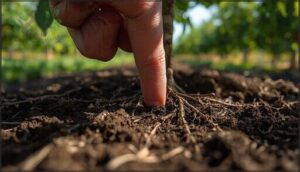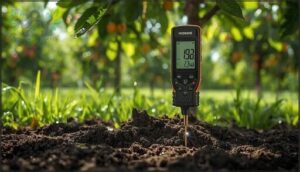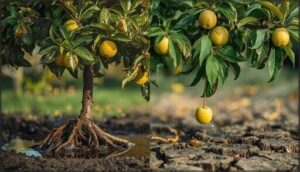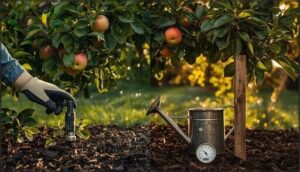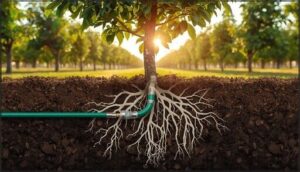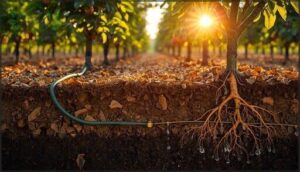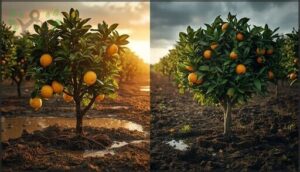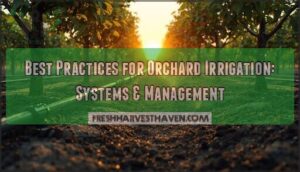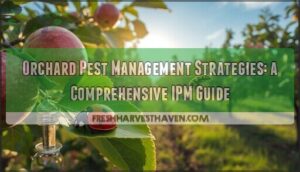This site is supported by our readers. We may earn a commission, at no cost to you, if you purchase through links.
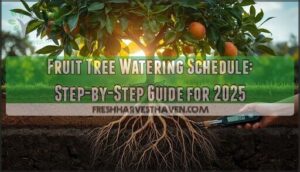
The good news is that dialing in your fruit tree watering schedule isn’t complicated once you understand what actually drives those needs. A few simple checks—and some adjustments through the seasons—keep your trees healthy, productive, and resilient through dry spells and wet ones alike.
Table Of Contents
Key Takeaways
- Young trees need frequent shallow watering (2-3 times weekly) while mature trees thrive on deeper, less frequent soaking (every 10-14 days) because root systems develop differently with age.
- Check soil moisture with your finger at 3-4 inches depth before watering—if it’s dry, water deeply; if moist, wait—since overwatering causes root rot faster than underwatering damages trees.
- Seasonal adjustments matter more than a fixed schedule: summer requires triple attention with peak heat demanding deep soaking, while winter dormancy needs watering only every 4-6 weeks if soil is dry.
- Mulch, drip irrigation, and basin-building around the drip line work together to retain moisture and reduce watering frequency, cutting down on how often you need to water while protecting tree health through unpredictable weather.
Key Factors Affecting Fruit Tree Watering
Not every fruit tree drinks from the same cup, and understanding what influences their thirst is the first step toward mastering your watering routine. Your tree’s needs shift based on factors you can see and measure—from the age of the tree itself to what’s happening in the soil beneath your feet.
Understanding what influences your fruit tree’s thirst—from its age to the soil beneath its roots—is the first step toward mastering your watering routine
Let’s walk through the four main elements that’ll shape how you water throughout 2025.
Tree Age and Size
A sapling that barely reaches your knee and a mature specimen spreading twenty feet wide don’t just look different—they drink at entirely different rates. Young trees demand frequent watering—two to three times weekly—because their shallow root systems haven’t yet anchored deep into moisture reserves.
As tree growth progresses and root development expands, mature trees tolerate drought better and only need weekly attention, freeing up your watering schedule while still supporting healthy fruit yield.
Soil Type and Drainage
Your tree’s thirst depends on what it’s rooted in. Sandy soils drain fast, retaining under 10% moisture, so you’ll water twice as often as someone with loamy ground, which holds around 20–25% and strikes that sweet balance. Clay, though? It clings to over 40% water by volume, which sounds great until root rot sets in.
Check soil drainage before you settle into any watering rhythm, because three feet of well-drained soil keeps roots healthy and deep watering actually effective. Understanding soil needs is vital for maintaining a healthy fruit tree.
Climate and Rainfall Patterns
Your climate zones dictate whether you’re watering citrus weekly in the subtropics or giving apples a deep soak every ten days in temperate regions. Rainfall variations mean you’ll suspend watering after storms—use a rain gauge to track precipitation—and ramp up drip irrigation during drought management periods when evapotranspiration rates spike and water stress threatens fruit size and quality.
Effective water conservation methods like greywater systems can help mitigate these issues.
Bare Root Vs. Potted Trees
Once you’ve got your watering rhythm tuned to climate and rainfall, how you planted your tree—bare root or potted—shapes those first critical months of establishment.
Bare root trees demand aggressive watering—twice daily for weeks—because root establishment and soil adaptation are racing against water absorption deficits.
Potted trees arrive with intact rhizospheres, easing tree acclimation and extending your initial watering schedule, though plant hardening and proper fruit tree watering techniques still matter.
How to Check Soil Moisture Effectively
Before you reach for the hose, you need to know if your tree actually needs water. The difference between thriving roots and rotting ones often comes down to checking soil moisture the right way.
Here are three reliable methods to assess when your fruit trees are thirsty.
The Finger Test Technique
You don’t need fancy tools to know when your tree’s thirsty—your index finger works just fine. Push it down into the soil about 3-4 inches near the root zone. If it feels dry at that depth, it’s time for deep watering. Moist soil means you can wait. This simple finger testing method gives you accurate moisture levels without guessing.
Using a Digital Soil Moisture Meter
For more precision—especially when you’re managing multiple trees or working with finicky soil conditions—a digital moisture meter takes the guesswork out of the equation. Insert the sensor placement about 6-8 inches deep to get accurate moisture readings at root level.
Digital accuracy means you’ll know exactly when irrigation management needs adjustment, protecting your soil health without constant finger testing. Just remember meter calibration matters—cheap soil sensors can give inconsistent results.
Signs of Overwatering and Underwatering
Recognizing leaf stress early prevents serious root damage and tree decline. Overwatering leads to persistent yellowing leaves and waterlogged soil with foul odors—classic signs of root rot threatening soil drainage. Underwatering shows up as curled, brown-edged leaves and premature fruit drop. Here’s what to watch for when watering fruit trees:
- Soggy soil staying wet for days signals water logging at tree roots
- Yellowing foliage with fragile leaves indicates oxygen-starved roots
- Curling, browning leaf edges reveal drought stress and soil moisture deficits
- Early fruit drop or undersized fruit points to inconsistent watering
- Foul-smelling soil near the root zone confirms severe root rot
Step-by-Step Fruit Tree Watering Schedule
You already know your soil’s moisture level—now it’s time to put that knowledge into practice. A solid watering schedule balances your tree’s age, the changing seasons, and whatever weather throws your way.
Let’s break down exactly when and how much to water throughout the year.
Watering Frequency for Young Vs. Mature Trees
A young sapling drinks like it’s preparing for a marathon, while an established tree sips water with the leisure of a retiree on a porch swing. Here’s how watering frequency shifts with tree age and root development:
| Tree Growth Stages | Watering Frequency | Root Development Notes |
|---|---|---|
| Young trees (1-3 years) | 2-3 times weekly | Shallow roots require consistent moisture to prevent water stress |
| Established trees (4-7 years) | Once weekly | Expanding root systems improve soil conditioning and drought tolerance |
| Mature trees (8+ years) | Every 10-14 days | Deep taproots access groundwater, supporting peak fruit yield |
Young trees haven’t built the infrastructure to hunt for moisture yet, so you’re their lifeline. Mature trees? They’ve got root systems that can tap into reserves you can’t even see.
Seasonal Adjustments (Spring, Summer, Fall, Winter)
Seasonal evapotranspiration drives the heartbeat of fruit tree watering—peaking in July’s heat and slowing to a whisper by December. Here’s how soil moisture needs shift through the year:
- Spring Hydration (mid-March to May): Start supplemental watering as buds swell; young trees need 10–15 gallons once or twice weekly, while mature trees tap into snowmelt reserves.
- Summer Drought (June–August): Triple your attention—peak heat demands one gallon per square foot of canopy weekly, often requiring drip irrigation three to four times per week.
- Fall Shift (September–November): Taper watering to every 10–14 days as evapotranspiration drops; trees now need just 30% of summer volumes by late November.
- Winter Dormancy (December–February): Deep-water every 4–6 weeks only if soil’s dry and unfrozen; dormant fruit trees barely drink.
- Fruit Tree Watering Techniques: Adjust intervals based on local ET data—frequency matters more than volume when tree care meets seasonal reality.
Adapting Schedule for Drought or Rainy Conditions
When weather throws curveballs—week-long downpours or relentless dry spells—your baseline schedule becomes more guideline than gospel.
During drought, extend drip irrigation runtime by 50% while checking soil moisture twice weekly for climate resilience.
After heavy rainfall monitoring shows saturated conditions, skip watering entirely until your finger test confirms the top 4 inches have dried—water conservation means adapting to what nature provides, not fighting it.
Best Watering Techniques for Healthy Trees
How you water matters just as much as when you water. The right technique delivers moisture deep into the root zone where your trees need it most, while poor methods waste water and can invite disease.
Let’s look at the approaches that actually work.
Deep Watering Methods
Deep watering isn’t about how often you water—it’s about getting moisture down where it actually matters, 12 to 18 inches below the surface where your tree’s feeder roots live. The goal is soil saturation at depth, not surface-level dampness.
Here’s how to achieve proper water penetration and root hydration:
- Run a slow trickle from your hose for 30-45 minutes, allowing gradual soil moisture absorption rather than runoff
- Create a basin around the drip line to capture water and direct it downward into the root zone
- Check penetration depth with a soil probe or long screwdriver—if it slides in easily 18 inches down, you’ve achieved a proper deep soak
This approach complements your fruit tree watering schedule by encouraging roots to grow deep, making trees more drought-resistant and less dependent on frequent irrigation.
Drip Irrigation and Watering Bags
If you’re ready to automate the whole process and stop babysitting a garden hose, drip irrigation systems and watering bags deliver consistent moisture right where your tree needs it—no guesswork, no wasted water.
A drip system paired with irrigation timers and soil sensors takes irrigation management off your plate entirely, adjusting your watering schedule based on real-time soil moisture levels.
Watering bags work beautifully for younger trees, releasing a slow, steady supply that prevents runoff while keeping roots evenly hydrated.
Why to Avoid Sprinklers
Sprinklers might seem convenient, but they’re one of the worst ways to water fruit trees—most of the water hits leaves instead of roots, inviting fungal problems while doing little to hydrate the soil where it counts.
You’ll also see water waste through evaporation, soil erosion from surface runoff, and uneven distribution that leaves some roots parched while drowning others.
Stick with drip irrigation or slow-release methods for irrigation management that actually protects your tree’s health.
Maximizing Soil Moisture Retention
You won’t keep your fruit trees thriving if water disappears before the roots can use it. Smart moisture retention makes every watering session count, cutting down on how often you need to grab the hose.
Let’s look at three proven ways to help your soil hold onto water longer.
Benefits of Mulching Around Fruit Trees
Think of mulch as a protective blanket that works overtime for your fruit trees. By spreading a layer around the base, you’ll retain soil moisture far more effectively—mulched soils show less fluctuation in moisture levels, delivering consistent hydration to roots even through unpredictable weather.
Here’s what proper mulching depth and tree maintenance deliver:
- Reduces watering frequency by minimizing evaporation
- Prevents soil erosion during heavy rainfall
- Suppresses weeds that compete for nutrients
- Improves soil health and nourishes beneficial microbes
Better moisture retention translates directly to improved tree health and fruit yield, especially during those scorching summer months when watering fruit trees becomes your main concern.
Choosing The Right Mulch Materials
Not all mulches are created equal—wood chips, straw, and compost each bring distinct advantages to your fruit tree’s root zone. Organic mulch like shredded bark improves soil health through nutrient cycling, while compost accelerates carbon sequestration and balances soil pH.
Apply 3-4 inches of mulch thickness around your tree, keeping it away from the trunk to prevent rot—this simple fruit tree maintenance step dramatically improves soil drainage and reduces how often you’re watering fruit trees.
Preventing Water Runoff and Evaporation
Every drop that rolls off sloped ground or vanishes into thin air is water your tree never gets to use—so building a shallow basin around the drip line turns rainfall and irrigation into a reservoir instead of runoff. Here’s how to lock in moisture and stop soil erosion:
- Shape a 2-3 inch berm to capture every gallon—runoff prevention starts with smart irrigation management
- Layer mulch for evaporation control and water conservation
- Install drip irrigation to deliver precisely where roots need it
- Improve soil drainage to prevent puddling while retaining moisture
- Practice drought management by watering fruit trees deeply but less often
Common Watering Mistakes to Avoid
Even experienced growers can make watering mistakes that compromise their fruit trees’ health. From drowning roots with too much water to missing critical seasonal shifts, these errors can set back your harvest by months or even years.
Let’s walk through the three most common pitfalls and how you can steer clear of them.
Overwatering and Root Rot
Too much water might seem like kindness, but it’s one of the fastest ways to kill a fruit tree. When you’re watering fruit trees, waterlogged soil starves roots of oxygen, triggering root rot and fungal diseases that spread fast. Poor soil drainage accelerates tree decline—you’ll need proper soil aeration to prevent root decay.
| Warning Sign | What It Means |
|---|---|
| Yellow, wilting leaves | Roots can’t breathe in saturated soil |
| Mushy, dark roots | Root decay from fungal diseases |
| Standing water near trunk | Soil drainage failure—emergency fix needed |
| Foul soil odor | Anaerobic conditions from overwatering |
| Stunted growth despite watering | Root rot blocking nutrient uptake |
Underwatering and Stress Symptoms
Your fruit tree won’t always tell you it’s thirsty until the damage is already done—by then, stressed roots are struggling to recover and fruit production has taken a serious hit. Watch for these telltale signs of water stress:
- Leaf wilting during midday heat that doesn’t bounce back
- Premature fruit drop before harvest
- Brittle, curling leaves with brown edges
- Stunted growth despite adequate soil moisture levels
Chronic underwatering accelerates tree decline and tanks drought tolerance, so check soil before symptoms appear.
Ignoring Seasonal and Weather Changes
Sticking to the same watering routine year-round is like wearing a winter coat in July—you’re not adapting to what’s actually happening around you. Climate variations and seasonal shifts directly affect watering frequency, yet many growers ignore weather forecasting and regional patterns when scheduling irrigation. Temperature fluctuations alter soil moisture demands, and without adjusting your fruit tree watering guidelines based on real-time climate conditions, you’re either drowning roots or starving them—both wreck drought tolerance.
| Season | Climate Conditions | Adjust Watering Frequency |
|---|---|---|
| Spring | Moderate temps, variable rain | Check soil moisture weekly |
| Summer | High heat, low humidity | Increase to 2x per week |
| Fall | Cooling temps, dormancy prep | Gradually reduce frequency |
| Winter | Cold, dormant trees | Minimal to none unless dry |
Frequently Asked Questions (FAQs)
How much water does each fruit tree need daily?
Most fruit trees need about one gallon of water per square foot of canopy weekly. However, watering frequency matters more than daily amounts.
Young trees usually need 2-3 times weekly watering, while mature trees do well with weekly deep soaking. Adjust based on rainfall, soil type, and seasonal conditions to maintain consistent soil moisture without waterlogging.
Can I water fruit trees in the evening or at night?
Evening watering works well for fruit trees since it reduces evaporation and gives roots time to absorb moisture overnight. However, avoid wetting foliage late in the day—wet leaves promote fungal diseases.
Water the soil directly at the tree’s base, and confirm good drainage so the ground doesn’t stay waterlogged through the night.
How do I adjust watering for newly transplanted trees?
Transplant shock hits hard—newly planted trees need consistent moisture as roots establish in unfamiliar soil. Water deeply 2-3 times weekly for the first month, checking soil moisture regularly.
Gradually reduce frequency as root establishment progresses, preventing water stress while promoting tree resilience and soil acclimation.
Can I use rainwater or collected water for fruit trees?
Rainwater and collected water work great for fruit trees—they’re often better than tap water since they lack chlorine and minerals. Set up rain barrels or gutters to harvest rainfall, then use drip irrigation or watering bags to deliver it efficiently.
Grey water from household sources works too, provided it’s free of soap and chemicals. This water conservation approach reduces your environmental footprint while supporting healthy soil and consistent moisture for better fruit production.
Conclusion
Your fruit tree watering schedule is less like a smartphone—which demands constant charging—and more like a well that deepens with time. Young trees need frequent, shallow hydration; established ones thrive on deeper, less frequent soakings.
Check soil moisture regularly, adjust for seasons, and trust mulch to do half the work. Master these fundamentals, and you’ll grow trees that produce abundantly for decades, not years.
- https://www.reddit.com/r/Permaculture/comments/1c798s2/young_fruit_tree_watering_requirements/
- https://www.marthastewart.com/how-often-water-fruit-trees-11739748
- https://treefruit.wsu.edu/web-article/irrigation/
- https://mgscchelpdesk.zohodesk.com/portal/en/kb/articles/how-much-to-water-fruit-trees
- https://www.rainbird.com/homeowners/blog/your-guide-to-fruit-tree-irrigation-and-efficient-water-use

